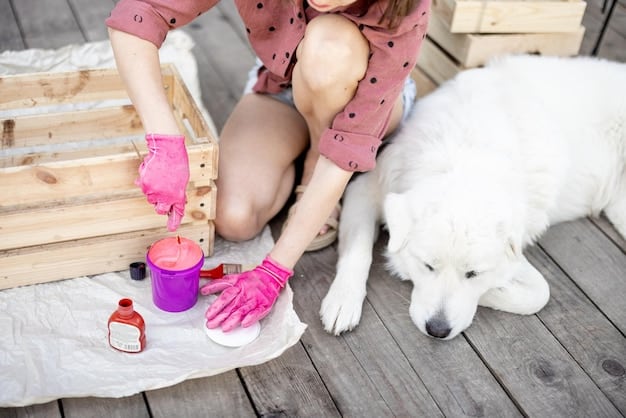Potty Training Regression: 3 Proven Methods This Month

Potty training regression in dogs can be frustrating, but understanding the causes and implementing consistent, positive reinforcement techniques, along with addressing underlying issues, can help get your furry friend back on track this month.
Discover effective strategies to tackle potty training regression in your dog this month. With patience and the right approach, you can overcome setbacks and reinforce good habits.
Understanding Potty Training Regression in Dogs
Potty training can be a long and challenging process. While you might think your dog has finally mastered it, potty training regression can occur, leading to accidents inside the house. Understanding why this happens is the first step to solving the problem.
Potty training regression refers to when a dog, who was previously reliably house-trained, starts having accidents indoors again, and it is essential to address regression promptly to prevent the behavior from becoming ingrained.
Common Causes of Potty Training Regression
There are several reasons why your dog might be experiencing potty training regression. Identifying the root cause is crucial for implementing the right solution:
- Medical Issues: Urinary tract infections, kidney problems, or diabetes can lead to increased urination. Consult a vet to rule out any underlying health conditions.
- Stress and Anxiety: Changes in the environment, loud noises, new family members, or separation anxiety can trigger regression.
- Changes in Routine: A new work schedule, moving to a new house, or changes in feeding times can disrupt your dog’s established potty routine.
- Incomplete Initial Training: Your dog might not have been fully trained in the first place.
Once these causes are identified, you can move forward to effectively addressing the specific reason your dog is experiencing regression and get him back on track in no time.

Method 1: Rule Out Medical Issues
The first and most important step in dealing with potty training regression is to rule out any possible medical causes. Health problems can often manifest as changes in your dog’s bathroom habits.
It’s crucial not to assume that regression is solely behavioral without considering potential health concerns.
Why a Vet Visit is Essential
A visit to the veterinarian can help identify underlying medical issues that may be causing the regression. The vet will conduct a thorough examination and run necessary tests to determine if your dog’s accidents are due to a health problem.
- Urinary Tract Infections (UTIs): UTIs can cause frequent urination and discomfort, leading to accidents.
- Kidney Disease: Impaired kidney function can result in increased thirst and urination.
- Diabetes: Diabetes can cause increased urination as the body tries to eliminate excess sugar.
- Hormonal Imbalances: Conditions like Cushing’s disease can also affect urination habits.
If a medical issue is identified, the vet can provide appropriate treatment, which should resolve the regression. However, even if the medical cause is ruled out, it is important to have a veterinarian confirm your dog’s health is in good condition.
Method 2: Revisit Potty Training Basics
Sometimes, potty training regression happens because the initial training wasn’t as solid as you thought. Revisit the basic principles with renewed consistency and patience to re-establish proper habits.
Start from square one and reinforce the fundamentals of house training. Ensure you’re setting your dog up for success once more.
Reinforce Positive Reinforcement
Positive reinforcement is key to successful potty training. Reward your dog immediately after they eliminate outside with praise, treats, or a favorite toy. This helps them associate going potty outside with positive outcomes.
- Consistent Schedule: Take your dog out at regular intervals, such as first thing in the morning, after meals, and before bedtime.
- Designated Potty Spot: Always take your dog to the same spot outside to eliminate. The familiar smells will encourage them to go.
- Reward Immediately: Carry treats with you and reward your dog within seconds of them finishing their business outside.
Avoid punishing your dog for accidents. Punishment can create fear and anxiety, which can worsen the regression. Instead, focus on rewarding good behavior, and it is essential to remain as consistent as possible throughout the training.
Method 3: Address Anxiety and Stress
Anxiety and stress are significant triggers for potty training regression. Environmental changes, separation problems, or loud noises can all contribute to your dog’s distress.
Identify and address the sources of anxiety to help restore your dog’s confidence and stability.
Identifying Stress Triggers
Pay attention to your dog’s behavior to identify potential stressors. Common triggers include:
- Loud Noises: Fireworks, thunderstorms, or construction noises.
- Changes in the Home: New furniture, renovations, or visitors.
- Separation Anxiety: Being left alone, even for short periods.
- New Pets or Family Members: Introducing a new animal or person to the household.
By recognizing these triggers, you can take steps to minimize your dog’s exposure to them. Create a safe and comfortable environment, especially during stressful times, and try to maintain a consistent routine.

Creating a Safe and Stable Environment
A safe and stable environment is crucial for reducing anxiety and preventing regression. Provide your dog with a designated space where they feel secure and comfortable.
A crate or a quiet corner with a comfortable bed can serve as a safe haven.
Techniques for Reducing Anxiety
Here are some strategies to help your dog manage anxiety:
- Calming Aids: Use pheromone diffusers or calming supplements recommended by your vet.
- Desensitization: Gradually expose your dog to stressful stimuli in a controlled manner.
- Positive Associations: Pair stressful situations with positive rewards, such as treats or praise.
- Exercise and Mental Stimulation: Regular physical activity and mental challenges can help reduce anxiety.
If separation anxiety is a major issue, consider consulting with a professional dog trainer or behaviorist. They can provide tailored strategies to teach your dog to cope with being alone and remember to always be patient and understanding.
Consistency and Patience
Consistency is paramount in addressing potty training regression. Stick to a structured routine, and ensure that everyone in the household is on board with the training plan, making adjustments and reinforcing the desired behaviors when necessary.
Maintaining a consistent approach helps reinforce good habits and prevents confusion.
Establishing a Consistent Routine
A well-defined routine provides your dog with a sense of security and predictability. Key elements of a consistent routine include:
- Feeding Schedule: Feed your dog at the same times each day.
- Potty Breaks: Take your dog out to eliminate at consistent intervals.
- Exercise Schedule: Provide regular physical activity and mental stimulation.
Avoid making sudden changes to your dog’s routine, as this can trigger anxiety and regression. When changes are unavoidable, introduce them gradually and provide extra reassurance. It is also extremely important during this time to remain patient.
What to Avoid During Regression
While addressing potty training regression, there are several common mistakes to avoid. These actions can worsen the problem and create additional stress for your dog.
Understanding what not to do is just as important as knowing what steps to take.
Common Mistakes to Avoid
Here are some of the common errors pet owners make during potty training regression:
- Punishment: Never punish your dog for having accidents indoors. Punishment can create fear and anxiety, making the problem worse.
- Inconsistency: Avoid changing your training methods or routine abruptly. Inconsistency can confuse your dog and hinder progress.
- Ignoring Medical Issues: Don’t assume the regression is solely behavioral without ruling out medical causes first.
By avoiding these mistakes and staying focused on positive reinforcement and consistent training, you can help your dog overcome potty training regression and regain their confidence but most importantly, always speak to your dog softly and not in an angry tone.
| Key Point | Brief Description |
|---|---|
| 🩺 Rule Out Medical Issues | Consult a vet to check for UTIs, kidney problems, or diabetes. |
| 🦴 Revisit Potty Training Basics | Use positive reinforcement and a consistent schedule. |
| 😟 Address Anxiety and Stress | Identify stressors and create a safe, stable environment. |
| 🐕🦺 Consistency is Key | Stick to a routine and avoid punishments. |
FAQ
▼
Medical issues, anxiety, changes in routine, or incomplete initial training can cause a previously house-trained dog to start having accidents. It’s often a sign that something is disrupting their established habits.
▼
Medical issues are often accompanied by other symptoms like increased thirst, straining to urinate, or changes in appetite. If you notice these or are unsure, consult your vet to rule out health problems.
▼
Clean up accidents thoroughly with an enzymatic cleaner to eliminate odors that might attract your dog to repeat the behavior. Avoid punishing your dog, just ignore the accident and focus on reinforcing positive habits.
▼
The time it takes to correct potty training regression varies depending on the cause and your dog’s individual temperament. Consistency and patience are key, and it may take days or several weeks to see improvement.
▼
If you’ve tried addressing the regression on your own without success, or if your dog is showing severe anxiety, consult a professional dog trainer or behaviorist. They can provide personalized strategies for solving any issues.
Conclusion
Potty training regression can be a frustrating experience, but by understanding the underlying causes and implementing consistent, positive training methods, you can help your dog get back on track. Remember to rule out medical issues, revisit basic training principles, address any anxiety or stress, maintain consistency, and avoid punishment. With patience and the right approach, you can overcome the setbacks and restore your dog’s good habits.





